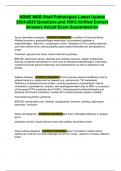NBME MBB Shelf Pathologies Latest Update
2024-2025 Questions and 100% Verified Correct
Answers Actual Exam Guaranteed A+
Acute intermittent porphyria - CORRECT ANSWER: A condition of heme synthesis.
Affected enzyme is porphobilinogen deaminase, accumulated substrate is
porphobilinogen, delta-ALA, uroporphyrin (urine). Symptoms (5 P's): painful abdomen,
port wine-colored urine, polyneuropathy, psychological disturbances, precipitated by
drugs
Treatment: glucose and heme, which inhibit ALA synthase.
BRS BS: abdominal cramps, diarrhea and vomiting, seizures, cardiac arrhythmias,
flushing, purple/red discoloration of urine due to elevated porphobilinogen. Psychiatric
symptoms include paranoid delusions and hallucinations as well as depression and
anxiety.
Addison Disease - CORRECT ANSWER: Chronic primary adrenal insufficiency due to
adrenal atrophy or destruction by disease (e.g. autoimmune, TB, metastasis).
Deficiency of aldosterone and cortisol, causing hypotension (hyponatremic volume
contraction), hyperkalemia, acidosis, skin hyperpigmentation (due to MSH, a by-product
of increased ACTH production from POMC). Characterized by Adrenal Atrophy and
Absence of hormone production; involves All 3 cortical divisions (spares medulla).
Associated psychiatric symptoms.
BRS BS: hypotension, pain, fainting, hypoglycemia, diarrhea, vomiting, depression,
psychosis, confusion
Alexia and agraphia - CORRECT ANSWER: part due to disrupted pathways in angular
gyrus
pathways connect visual projection area with auditory association areas
Alexia without agraphia - CORRECT ANSWER: lesion of posterior cerebral artery;
patient can write but not read; language cut off from visual - splenum of corpus callosum
lesion
, Alzheimer's Disease - CORRECT ANSWER: Most common Dementia. Nucleus basalis
of Meynert undergoes degeneration --> loss of ACh in cortex leading to neural atrophy
in cortex and hippocampus
Cholinesterase inhibitors (galantamine) are treatment - increase available ACh (caution
with bradycardia and ulcers patients); cause GI side effects (possible anorexia,
insomnia)
Glutamate-mediated excitotoxicity also implicated in pathogenesis
- memantine (trade name Namenda) is an NMDA antagonist
Down Syndrome predisposes for Alzheimers
Familial form (10%) associated with:
- Early onset: APP (c21), presenilin-1 (c14), presenilin-2 (c1)
- Late onset: ApoE4 (c19)
ApoE2 is protective
Angelman's syndrome - CORRECT ANSWER: Maternal allele is not expressed. Mental
retardation, seizures, ataxia, inappropriate laughter. Genetic component on component
15.
Anorexia nervosa - CORRECT ANSWER: Excessive dieting +/- purging; intense fear of
gaining weight, body image distortion, increase in exercise, leading to body weight less
than 85% of ideal body weight (17.5 BMI)
- associated with low bone density
Severe weight loss, metatarsal stress fractures, amenorrhea, anemia, electrolyte
disturbances. Commonly coexists with depression
*increased chance of osteoporosis
Arnold-Chiari malformation II - CORRECT ANSWER: Significant cerebellar tonsillar and
vermian herniation through foramen magnum with aqueductal stenosis and
hydrocephalus. Often present with thoraco-lumbar myelomeningocele and paralysis
below the defect.
Arnold-Chiari malformation with or without myelomeningocele is characterized by a
cerebellomedullary malformation that may not develop until adolescence or adult life.




